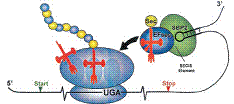Biochemistry, Department of

Vadim Gladyshev Publications
Document Type
Article
Date of this Version
April 2007
Abstract
The human selenoproteome consists of 25 known selenoproteins, but functions of many of these proteins are not known. Selenoprotein H (SelH) is a recently discovered 14-kDa mammalian protein with no sequence homology to functionally characterized proteins. By sensitive sequence and structure analyses, we identified SelH as a thioredoxin fold-like protein in which a conserved CXXU motif (cysteine separated by two other residues from selenocysteine) corresponds to the CXXC motif in thioredoxins. These data suggest a redox function of SelH. Indeed, a recombinant SelH shows significant glutathione peroxidase activity. In addition, SelH has a conserved RKRK motif in the N-terminal sequence. We cloned wild-type and cysteine mutant forms of SelH either upstream or downstream of green fluorescent protein (GFP) and localized this fusion protein to the nucleus in transfected mammalian cells, whereas mutations in the RKRK motif resulted in the cytosolic protein. Interestingly, the full-length SelH-GFP fusion protein localized specifically to nucleoli, whereas the N-terminal sequence of SelH fused to GFP had a diffuse nucleoplasm location. Northern blot analyses revealed low expression levels of SelH mRNA in various mouse tissues, but it was elevated in the early stages of embryonic development. In addition, SelH mRNA was overexpressed in human prostate cancer LNCaP and mouse lung cancer LCC1 cells. Down-regulation of SelH by RNA interference made LCC1 cells more sensitive to hydrogen peroxide but not to other peroxides tested. Overall, these data establish SelH as a novel nucleolar oxidoreductase and suggest that some functions in this compartment are regulated by redox and dependent on the trace element selenium.


Comments
Published in THE JOURNAL OF BIOLOGICAL CHEMISTRY, VOL. 282, NO. 16, pp. 11960–11968, April 20, 2007.